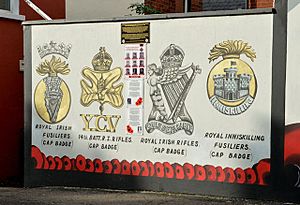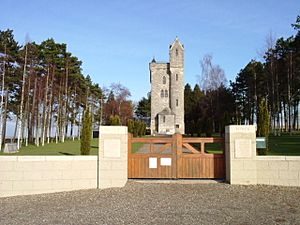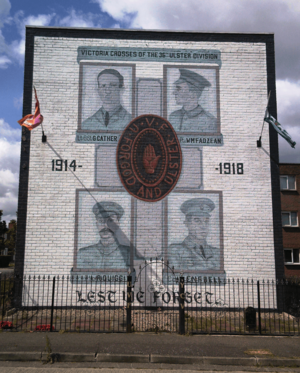36th (Ulster) Division facts for kids
Quick facts for kids 36th (Ulster) Division |
|
|---|---|
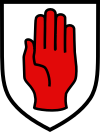 |
|
| Active | September 1914 – January 1919 |
| Country | |
| Branch | |
| Type | Infantry |
| Size | Division |
| Engagements | World War I |
The 36th (Ulster) Division was a special group of soldiers in the British Army during World War I. It was formed in September 1914. This division was part of a larger group called "Kitchener's Army," named after Lord Kitchener, a famous British general.
The division was first called the Ulster Division. Most of its members were from the Ulster Volunteers, a group of people from Ulster who wanted to stay part of the United Kingdom. They formed new battalions (smaller groups of soldiers) for three existing regiments: the Royal Irish Fusiliers, the Royal Irish Rifles, and the Royal Inniskilling Fusiliers. The division fought on the Western Front in France and Belgium from October 1915 until the end of the war.
The division's symbol was the Red Hand of Ulster, a famous sign from the region.
Contents
History of the Ulster Division
How the Division Started
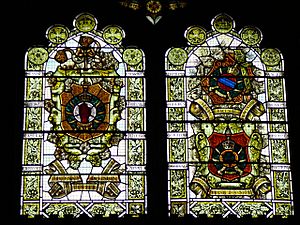
The Ulster Volunteers were a group formed in 1912. They were called unionists because they wanted Ireland to remain part of the United Kingdom. They created the Ulster Volunteer Force in 1913 to resist a new law called the Third Home Rule Act. This law would have given Ireland its own government in Dublin. Many people in Ulster, especially Protestants, worried about this change and wanted to keep their strong ties with Britain.
When World War I began, Sir Edward Carson, a leader of the unionists, asked the Ulster Volunteers to join the army. Lord Kitchener hoped for a small group of men, but instead, he got enough volunteers to form an entire division, which is a much larger military unit. Major-General Oliver Nugent became the commander in September 1915, and the division moved to France in October 1915.
Key Battles
The Somme, 1916
The Ulster Division played a big part on the first day on the Somme (July 1, 1916). They were one of the few divisions that managed to gain ground against the German forces. They attacked between two places called the Ancre and Thiepval, aiming for a strong German position known as the Schwaben Redoubt.
According to military historian Martin Middlebrook:
The leading battalions [of the Ulster Division] had been ordered out from the wood just before 7.30am and laid down near the German trenches [...] At zero hour the British barrage lifted. Bugles blew the "Advance". Up sprang the Ulstermen and, without forming up in the waves adopted by other divisions, they rushed the German front line [...] By a combination of sensible tactics and Ulster dash, the prize that eluded so many, the capture of a long section of the German front line, had been accomplished.
The Ulster Division was the only division in its army corps to achieve its goals on the first day. However, this success came at a very high cost. In just two days, about 5,500 officers and soldiers were killed, wounded, or went missing. A war reporter named Philip Gibbs said their attack was "one of the finest displays of human courage in the world."
Out of nine Victoria Crosses (the highest award for bravery in the British military) given to British soldiers in this battle, four went to soldiers from the Ulster Division.
Actions of the 36th Division
The Ulster Division's part of the Somme battlefield was near the marshy valley of the River Ancre and higher ground. Their mission was to cross a ridge and capture the German second line of defense. They had to get past the German front line and a strong point called the Schwaben Redoubt.
July 1st was also the anniversary of the Battle of the Boyne, an important historical event for Ulstermen. Some stories say that men wore orange sashes or ribbons into battle to show their pride.
On July 1st, after a heavy bombardment, the Ulstermen quickly took the German front line. They moved so fast that the German soldiers didn't have time to get out of their deep underground shelters. They even captured the Schwaben Redoubt. By 10:00 AM, some soldiers had reached the German second line.
However, their success was not matched by other divisions on their sides. This left the Ulstermen exposed to attacks from three directions. They started running out of ammunition and supplies. A strong German counter-attack at 10:00 PM forced them to retreat, giving up almost all the ground they had gained.
The division suffered over 5,000 casualties, with 2,069 soldiers killed. The Thiepval Memorial in France remembers the soldiers who died in the 1916 Somme offensive, including those from the Ulster Division. It is the largest British war memorial for missing soldiers on the Western Front, remembering more than 73,000 men.
Ulster Memorial Tower
The Ulster Memorial Tower was opened in Thiepval, France, on November 19, 1921. It was built to honor the 36th (Ulster) Division's bravery during World War I. The tower stands where the Schwaben Redoubt was, the strong German position the Ulster Division attacked on the first day of the Somme.
Money for the tower was raised by people in Northern Ireland to remember the soldiers of the Ulster Division and all Ulstermen who died in the war.
The tower looks like Helen's Tower in Clandeboye, County Down. This was where the Ulster Division soldiers trained when they first formed. For many, Helen's Tower was one of their last memories of home before going to war.
Messines, 1917
The Ulster Division was also heavily involved in the Battle of Messines (June 7–14, 1917). Many of its soldiers are buried in cemeteries like Spanbroekmolen British Cemetery and Lone Tree Commonwealth War Graves Commission Cemetery on Messines Ridge.
Victoria Cross Heroes
Nine members of the Ulster Division were awarded the Victoria Cross, the highest award for bravery in the British military. Here are some of them:
- Captain Eric Norman Frankland Bell, 9th Battalion the Royal Inniskilling Fusiliers. He died at 20 years old on July 1, 1916, during the Battle of the Somme.
- 2nd Lieutenant James Samuel Emerson, 9th Battalion the Royal Inniskilling Fusiliers. He died at 22 years old on December 6, 1917.
- Lance Corporal Ernest Seaman, 2nd Battalion the Royal Inniskilling Fusiliers. He died at 25 years old on September 29, 1918. He also received the Military Medal.
- Fusilier Norman Harvey, 1st Battalion the Royal Inniskilling Fusiliers. Awarded for his brave actions on October 25, 1918.
- Second Lieutenant Edmund De Wind, 15th Battalion the Royal Irish Rifles. He died at 34 years old on March 21, 1918, during the Second Battle of the Somme.
- Rifleman William Frederick McFadzean, 14th Battalion the Royal Irish Rifles. He died at 20 years old on July 1, 1916, during the Battle of the Somme.
- Rifleman Robert Quigg, 12th Battalion the Royal Irish Rifles. Awarded for his actions during the Battle of the Somme on July 1, 1916.
- Lieutenant Geoffrey Cather, 9th Battalion the Royal Irish Fusiliers. He died at 25 years old on July 2, 1916, during the Battle of the Somme.
High Praise for the Division
After the first day of the Somme, Captain Wilfred Spender of the Ulster Division's headquarters staff said:
I am not an Ulsterman, but yesterday as I followed their amazing attack I felt that I would rather be an Ulsterman than anything else in the world [...] My pen cannot describe adequately the hundreds of heroic acts that I witnessed [...] The Ulster Division has lost more than half the men who attacked, and in doing so has sacrificed itself for the Empire which has treated them none too well. The much derided Ulster Volunteer Force has won a name which equals any in History. Their devotion, which no doubt has helped the advance elsewhere, deserves the gratitude of the British Empire. It is due to the memory of these brave heroes that their beloved Province shall be fairly treated.
After the war, King George V also praised the 36th Division, saying:
In these days of rejoicing I recall the deeds of the 36th (Ulster) Division, which have more than fulfilled the high opinion formed by me on inspecting that force on the eve of its departure for the front. Throughout the long years of struggle, which have now so gloriously ended, the men of Ulster have proved how nobly they fight and die.
Winston Churchill also spoke highly of the division:
The record of the Thirty-Sixth Division will ever be the pride of Ulster. At Thiepval in the battle of the Somme on 1 July 1916; at Wytschaete on 17 June 1917, in the storming of the Messines Ridge; on the Canal du Nord, in the attack on the Hindenburg Line of 20 November the same year; on 21 March 1918, near Fontaine-les-Clercs, defending their positions long after they were isolated and surrounded by the enemy; and later in the month at Andechy in the days of "backs to the wall", they acquired a reputation for conduct and devotion deathless in military history of the United Kingdom, and repeatedly signalised in the despatches of the Commander-in-Chief.
Units of the Division
The 36th (Ulster) Division was made up of several brigades, each with different battalions (smaller groups of soldiers). Here are some of the units that served:
- 8th (Service) Battalion (East Belfast), the Royal Irish Rifles
- 9th (Service) Battalion (West Belfast), the Royal Irish Rifles
- 10th (Service) Battalion (South Belfast), the Royal Irish Rifles
- 15th (Service) Battalion (North Belfast), the Royal Irish Rifles
- 1st Battalion, the Royal Irish Fusiliers
- 1st Battalion, the Royal Irish Rifles
- 2nd Battalion, the Royal Irish Rifles
- 108th Brigade
- 9th (Service) Battalion, the Royal Irish Fusiliers
- 12th (Service) Battalion (Central Antrim), the Royal Irish Rifles
- 2nd Battalion, the Royal Irish Rifles
- 11th (Service) Battalion (South Antrim), the Royal Irish Rifles
- 13th (Service) Battalion (County Down), the Royal Irish Rifles
- 1st Battalion, the Royal Irish Fusiliers
- 109th Brigade
- 9th (Service) Battalion (County Tyrone), the Royal Inniskilling Fusiliers
- 10th (Service) Battalion (County Londonderry), the Royal Inniskilling Fusiliers
- 11th (Service) Battalion (Donegal and Fermanagh), the Royal Inniskilling Fusiliers
- 14th (Service) Battalion (Young Citizens), the Royal Irish Rifles
- 1st Battalion, the Royal Inniskilling Fusiliers
- 2nd Battalion, the Royal Inniskilling Fusiliers
Commanders of the Division
- 1914–1915: Major-General C. H. Powell
- 1915 – May 6, 1918: Major-General Oliver Nugent
- May 6, 1918 – Disbandment: Major-General Clifford Coffin
Memorials to the Great War
Several memorials remember the 36th (Ulster) Division and other soldiers of World War I:
- Ulster Tower, Thiepval, France.
- Irish National War Memorial Gardens, Dublin.
- Island of Ireland Peace Park, Messines, Belgium.
- Menin Gate Memorial, Ypres, Belgium.
See also
- List of British divisions in World War I
- 10th (Irish) Division
- 16th (Irish) Division
- Observe the Sons of Ulster Marching Towards the Somme


